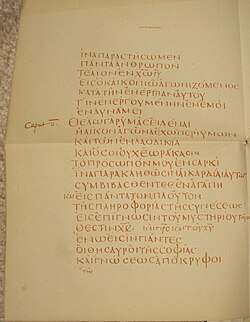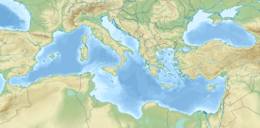Colossians 1: Difference between revisions
JohnThorne (talk | contribs) →Greeting (1:1–2): add header and text |
JohnThorne (talk | contribs) →Thanksgiving (1:3–8): add header and text |
||
| Line 53: | Line 53: | ||
==Thanksgiving (1:3–8)== |
==Thanksgiving (1:3–8)== |
||
In most of his letters,{{efn|Only the [[Epistle to the Galatians]], [[1 Timothy]] and [[Titus]] don't contain the thanksgiving section after the greeting.{{sfn|Murphy-O'Connor|2007|p=1192}}}} Paul follows the greeting with a thanksgiving to God for his recipients, which "carefully reflect Paul's assessment to the state of the community, and reveal his concerns".{{sfn|Murphy-O'Connor|2007|p=1192}} The information about the believers at Collosae was obtained from [[Epaphras]] ({{bibleref2|Colossians|1:4,8|NKJV}}),{{sfn|Murphy-O'Connor|2007|p=1193}} who was also from Collosae ({{bibleref2|Colossians|4:12|NKJV}}).<ref>{{cite book | last=Moo | first= Douglas J. | title=The Letters to the Colossians and to Philemon | publisher=William B. Eerdmans Publishing Company| authorlink=Douglas J. Moo | year=2008 | location=Grand Rapids | pages=90 | isbn=9781844743414}}</ref> |
In most of his letters,{{efn|Only the [[Epistle to the Galatians]], [[1 Timothy]] and [[Titus]] don't contain the thanksgiving section after the greeting.{{sfn|Murphy-O'Connor|2007|p=1192}}}} Paul follows the greeting with a thanksgiving to God for his recipients, which "carefully reflect Paul's assessment to the state of the community, and reveal his concerns".{{sfn|Murphy-O'Connor|2007|p=1192}} The information about the believers at Collosae was obtained from [[Epaphras]] ({{bibleref2|Colossians|1:4,8|NKJV}}),{{sfn|Murphy-O'Connor|2007|p=1193}} who was also from Collosae ({{bibleref2|Colossians|4:12|NKJV}}).<ref>{{cite book | last=Moo | first= Douglas J. | title=The Letters to the Colossians and to Philemon | publisher=William B. Eerdmans Publishing Company| authorlink=Douglas J. Moo | year=2008 | location=Grand Rapids | pages=90 | isbn=9781844743414}}</ref> |
||
==Prayer for the Future (1:9–11)== |
|||
The believers have been the object of Paul's constant concern, so he asks God to make them understand his will, do good works and persevere.{{sfn|Murphy-O'Connor|2007|p=1193}} |
|||
==Conversion (1:12–14)== |
|||
This section is actually still within one unbroken sentence with the previous, but in here Paul describes the crucial conversion of the believers into the form displayed by Christ, that is "by incorporation into Christ in baptism, the structures of the world are replaced by new values".{{sfn|Murphy-O'Connor|2007|p=1193}} |
|||
== Verse 15 == |
== Verse 15 == |
||
Revision as of 23:51, 6 May 2019
| Colossians 1 | |
|---|---|
 A page showing Epistle to the Colossians 1:28-2:3 on Codex Claromontanus from ca. AD 550. | |
| Book | Epistle to the Colossians |
| Category | Pauline epistles |
| Christian Bible part | New Testament |
| Order in the Christian part | 12 |


Colossians 1 is the first chapter of the Epistle to the Colossians in the New Testament of the Christian Bible. Traditionally, it is believed to be written for the church in Colossae by Apostle Paul while he was in prison in Ephesus (years 53-54), although there were debatable charges that it is the work of a secondary imitator or that it was written in Rome (in early 60s).[1] This chapter contains the greeting, thanksgiving and prayer, followed by a "Christological Hymn" and the thesis of the letter.[2]
Text
The original text is written in Koine Greek. This chapter is divided into 29 verses.
Some most ancient manuscripts containing this chapter are:
- Papyrus 46 (ca. AD 200)
- Codex Vaticanus (AD 325-350)
- Codex Sinaiticus (AD 330-360)
- Codex Alexandrinus (ca. AD 400-440)
- Codex Ephraemi Rescriptus (ca. AD 450; extant verses 3-29)
- Codex Freerianus (ca. AD 450; extant verses 1:1-4, 10-12, 20-22, 27-29)
- Codex Claromontanus (ca. AD 550)
- Codex Coislinianus (ca. AD 550; extant verses 26-29)
Greeting (1:1–2)
Verse 1
- Paul, an apostle of Jesus Christ by the will of God, and Timothy our brother,[3]
The mention of Timothy alone among the fellow believers who were with Paul at that time (Colossians 4:7–14) suggests that he was the co-author of this epistle.[4]
Verse 2
- To the saints and faithful brethren in Christ who are in Colosse:
- Grace to you and peace from God our Father and the Lord Jesus Christ.[5]
Paul's opening greeting in his epistles normally mentions "a double source of divine benefactions: 'from God our/the Father and the Lord Jesus Christ'.[4] The omission of the second element[a] may be due to the presence of 'in Christ' in the first part of this verse.[7]
Thanksgiving (1:3–8)
In most of his letters,[b] Paul follows the greeting with a thanksgiving to God for his recipients, which "carefully reflect Paul's assessment to the state of the community, and reveal his concerns".[4] The information about the believers at Collosae was obtained from Epaphras (Colossians 1:4,8),[8] who was also from Collosae (Colossians 4:12).[9]
Prayer for the Future (1:9–11)
The believers have been the object of Paul's constant concern, so he asks God to make them understand his will, do good works and persevere.[8]
Conversion (1:12–14)
This section is actually still within one unbroken sentence with the previous, but in here Paul describes the crucial conversion of the believers into the form displayed by Christ, that is "by incorporation into Christ in baptism, the structures of the world are replaced by new values".[8]
Verse 15
- He is the image of the invisible God, the firstborn over all creation.[10]
See Names and titles of Jesus in the New Testament.
Verse 18
- And He is the head of the body, the church, who is the beginning, the firstborn from the dead, that in all things He may have the preeminence.[11]
See also
- Colosse
- Epaphras
- Jesus Christ
- Paul of Tarsus
- Timothy
- Related Bible parts: Acts 9, 2 Corinthians 1, 2 Corinthians 4, 2 Corinthians 11, Philippians 3
Notes
- ^ The absence of the phrase 'and the Lord Jesus Christ' is notable in Codex Vaticanus. Codex Sinaiticus, Byzantine Majority Text and Textus Receptus all have the complete phrase, whereas Codex Alexandrinus omits 'the Lord'.[6]
- ^ Only the Epistle to the Galatians, 1 Timothy and Titus don't contain the thanksgiving section after the greeting.[4]
References
- ^ Murphy-O'Connor 2007, p. 1191–1192.
- ^ Murphy-O'Connor 2007, p. 1192–1194.
- ^ Colossians 1:1 NKJV
- ^ a b c d Murphy-O'Connor 2007, p. 1192.
- ^ Colossians 1:2 NKJV
- ^ N-A28 Apparatus on Colossians 1:2; Greek text analysis on Colossians 1:2 at Biblehub.com
- ^ Aletti, J.-N. (1993) Saint Paul: Epitre aux Colossiens, Ebib NS 20 (Paris: Gabalda) p. 46; apud Murphy-O'Connor 2007, p. 1192.
- ^ a b c Murphy-O'Connor 2007, p. 1193.
- ^ Moo, Douglas J. (2008). The Letters to the Colossians and to Philemon. Grand Rapids: William B. Eerdmans Publishing Company. p. 90. ISBN 9781844743414.
- ^ Colossians 1:15
- ^ Colossians 1:18
Bibliography
- Murphy-O'Connor, Jerome (2007). "70. Colossians". In Barton, John; Muddiman, John (eds.). The Oxford Bible Commentary (first (paperback) ed.). Oxford University Press. pp. 1191–1199. ISBN 978-0199277186. Retrieved February 6, 2019.

